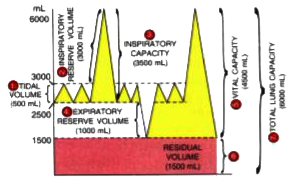Gaseous exchanges continue in lungs without interruption even during expiration. Explain.
Step-by-Step Solution:
1. Understanding Breathing Process: Breathing consists of two main phases: inspiration (inhaling) and expiration (exhaling). During inspiration, oxygen-rich air enters the lungs, and during expiration, carbon dioxide-rich air is expelled.
2. Role of Alveoli: The alveoli are tiny air sacs in the lungs where gas exchange occurs. They are surrounded by capillaries that carry deoxygenated blood (blue blood) and oxygenated blood (red blood). The exchange of gases (oxygen and carbon dioxide) takes place in the alveoli.
3. Continuous Gas Exchange: Gas exchange in the alveoli does not stop during expiration. While air is being expelled, oxygen continues to diffuse into the blood from the alveoli, and carbon dioxide diffuses from the blood into the alveoli to be exhaled.
4. Presence of Residual Air: Even after expiration, there is always a volume of air known as residual air (approximately 1200 ml) that remains in the lungs. This residual air prevents the lungs from collapsing and ensures that the alveoli remain partially inflated.
5. Maintaining Lung Shape: The residual air helps maintain the shape and structure of the lungs, allowing them to be ready for the next inhalation. This means that there is always some air in the alveoli, facilitating continuous gas exchange regardless of whether the person is inhaling or exhaling.
6. Conclusion: Therefore, the gaseous exchange in the lungs continues without interruption during expiration due to the presence of residual air, which keeps the alveoli filled and allows for ongoing diffusion of gases.
---
Similar Questions
Knowledge Check
Gaseous exchange continues in the lungs without interruption due to:
Apresence of residual airBcontinuous stimulationCpresence of erythrocytesDlarge number of alveoliSite of gaseous exchange in lungs is :
Apulmonary chamberBtracheaCbronchiolesDalveoliRead the following four statement (i) - (iv) with certain mistakes in two of them.
(i) A water breather expends much more energy in ventilating its respiratoru surface than an air-breathing one.
(ii) Lungs become empty after forceful expiration.
(iii) Exchange of gases in the lungs are interrupted during expiration.
Respiratory movement are controlled by CO2 concentration of arterial blood.
Which of the above two statements have mistakes ?A(i) and (iv)B(ii) and (iii)C(i) and (ii)D(iii) and (iv)
Explain why (or how) : (a) In a sound wave, a displacement node is a pressure antinode and vice-versa,
(b) Bats can ascertain distances, directions, nature and size of obstacles without any eyes,
(c) a violin note and sitar note may have the same frequency, yet we can distinguish between the two notes, (d) Solids can support both longitudinal and transverse waves, but only longitudinal waves can propagate in gases,
(e) The shape of pulse gets distorted during propagation in a dispersive medium.
View SolutionThe volume of air in the lungs and the rate at which it is exchanged during inspiration and expiration was measured.
The following diagram shows a group of the lung volumes and capacities :

Study the diagram carefully and explain briefly the following:
(a) Tidal volume
(b) Inspiratory reserve volume
(c) Expiratory reserve volume
(d) Vital capacity
(e) Residual volume
View SolutionThe volume of air remaining in the lungs even after a forcible expiration is
View SolutionVolume of air remaining in the lungs even after a forcible expiration is
View SolutionThe site of gaseous exchange in the lungs is:
View Solution
